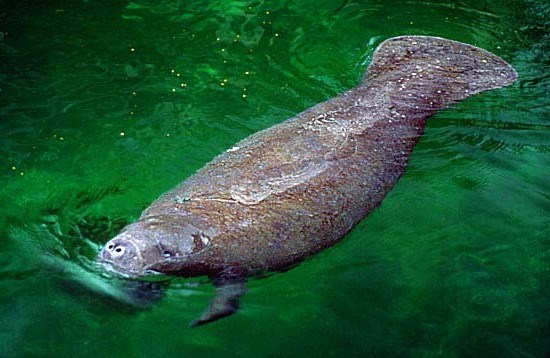|
Big Cypress National Preserve is home to 35 species of mammals, ranging in size from shrews and bats the weight of a nickel (~0.2 oz.) to the massive Florida manatee (up to 1,200 lbs.) Many of these mammals are creatures we would only expect to find in dry habitats, but here they have adapted to the more aquatic lifestyle of the swamp. Keep your eyes open as you visit the preserve. You might be surprised who you see! 
Appearance: Adults are a tawny brown with pale undersides and black on the tip of the tail, back of the ears, and sides of the muzzle. Kittens are gray with dark spots and five tail bands. Size: Males weigh 102-160 lbs. and measure ~7 ft. from nose to the tip of the tail. Females weigh 50-115 lbs. and measure ~6 ft. from nose to tail. Lifespan: 10+ years Habitat: Panthers prefer drier habitats, such as hardwood hammocks and pinelands, but will make use of sawgrass prairies and other areas of the swamp. Males possess home ranges of ~200 square miles, while females range over ~75 square miles, often sharing portions of their range with other females. Diet: Panthers are strictly carnivores, with white-tailed deer and feral hogs making up most of their diet. They will also hunt smaller animals such as raccoons, rabbits, armadillo, and birds. Reproduction: Panthers reach sexual maturity around two and a half years of age in females and three years in males. Pregnancy lasts approximately three months. Litters consist of 1-3 kittens. Kittens will begin leaving the den to learn how to hunt with their mother around two months of age. 
Appearance: Unlike other sub-species of black bears whose coat color can vary from black to brown to blonde, Florida black bears are always black, occasionally with brown noses and a pale spot on their chest. Size: On average, males weigh 250-450 lbs. and females weigh 125-250 lbs. Lifespan: Unknown. The oldest known Florida black bear was caught in 2014 at 22 years old. (Florida Fish And Wildlife Conservation Commission, n.d.) Habitat: Florida black bears make use of a variety of habitats, including hardwood hammocks, pinelands, and swamp. They prefer habitats with a dense understory. Diet: Black bears are omnivores. Their diet consists of approximately 80% plants, 15% insects, and 5% meat, most of which is scavenged. Reproduction: Sexual maturity occurs between the third and fourth year of the bear's life. Breeding season is from June to early August. The average litter consists of 2-3 cubs. Young bears will usually stay with their mother until the summer of their second year. 
Appearance: Manatees are grey, aquatic mammals with pudgy, elongated bodies. They have a rounded nose, two front flippers, and a large, paddle-like tail. Size: Adult manatees are around 9-10 feet in length. Females weigh an average of 1,000 lbs., while males average 750 lbs. Lifespan: 60+ years Habitat: Able to live in fresh, salt, or brackish water, manatees can be found in Florida’s springs, rivers, estuaries, and coastal areas. In the winter they concentrate in Florida’s warm waters while in the summer some will migrate, traveling west and north towards Alabama and South Carolina. Diet: Manatees are herbivores, consuming 10-15 percent of their body weight in seagrasses and other aquatic vegetation each day. Reproduction: Manatees reach sexual maturity around 3-5 years of age in females and 5-7 years in males. The female is pregnant for 12-14 months before producing one calf that will stay with its mother for up to two years. 
Appearance: These large squirrels come in a variety of color phases, ranging from orange to black to tan. They usually possess a white nose and ears. Big Cypress fox squirrels are known for their long bushy tails and powerful hind legs. Size: Reach 17-27 in. long and weigh 1-3 lbs. Habitat: Though considered a tree squirrel, Big Cypress fox squirrels spend most of their time on the ground. They can be found in pine forests, cypress swamp forests, tropical hardwood forests, oak woodlands, mangrove swamps, and suburban habitats such as golf courses. Diet: Big Cypress fox squirrels have a varied diet that includes seeds, cones, fungi, fruit, buds, and insects. Reproduction: Females become sexually mature as soon as eight months of age. Big Cypress fox squirrels have two primary breeding seasons, winter and summer, each lasting a couple of months. Pregnancy lasts approximately six weeks, with females giving birth to one or three offspring. Young squirrels are weaned when they are about twelve weeks old. References:Florida Fish And Wildlife Conservation Commission. (n.d.). Life expectancy. https://myfwc.com/wildlifehabitats/wildlife/bear/facts/life-expectancy/ |
Last updated: November 1, 2021
